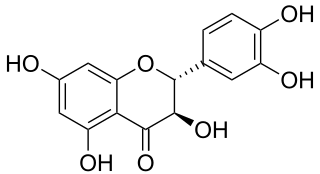| Taxifolina | ||
|---|---|---|
 | ||
| Nombre IUPAC | ||
|
(2R,3R)-2-(3,4-dihydroxyphenyl)-3,5,7-trihydroxy-2, 3-dihydrochromen-4-one | ||
| General | ||
| Otros nombres |
Dihydroquercetin Taxifoliol Distylin Catechin hydrate (+)-Taxifolin trans-Dihydroquercetin (+)-Dihydroquercetin | |
| Fórmula molecular | C15H12O7 | |
| Identificadores | ||
| Número CAS | 480-18-2[1] | |
| ChEBI | 17948 | |
| ChEMBL | 66 | |
| ChemSpider | 458 | |
| DrugBank | 02224 | |
| PubChem | 439533 | |
| UNII | 9SOB9E3987 | |
| KEGG | C01617 | |
|
OC1=C(C([C@H](O)[C@@H](C2=CC(O)=C(O)C=C2)O3)=O)C3=CC(O)=C1
| ||
| Propiedades físicas | ||
| Apariencia | marrón | |
| Masa molar | 304,25 g/mol | |
| Valores en el SI y en condiciones estándar (25 ℃ y 1 atm), salvo que se indique lo contrario. | ||
Taxifolin es un flavanonol, un tipo de flavonoide.
YouTube Encyclopedic
-
1/1Views:14 139
-
Organic Chemistry 51B. Lecture 20. Radicals.
Transcription
Producción natural
Se puede encontrar en las coníferas, como el alerce siberiano Larix sibirica, en Rusia, en Pinus roxburghii,[2] in Cedrus deodara[2] y en Taxus chinensis var. mairei.[3] También se puede encontrar en la palma de açaí, en el extracto de silimarina de las semillas de Silybum marianum y en pequeñas cantidades en la cebolla roja.
Farmacología
Taxifolina no es mutagénico y de bajo tóxico en comparación con el compuesto relacionado quercetina.[4] Actúa como un potencial agente quimiopreventivo mediante la regulación de los genes a través de un mecanismo de ARE-dependiente.[5] Taxifolina ha demostrado que inhibe el crecimiento celular del cáncer de ovario en una dosis de manera dependiente.[6] También hay una fuerte correlación (con un coeficiente de correlación de 0,93) entre los efectos antiproliferativos de dihidroquercetina (DHQ, taxifolina) de derivados en la piel de murino fibroblastos y células humanas de cáncer de mama.[7]
La capacidad de taxifolina para estimular la formación de fibrillas y promover la estabilización de las formas fibrilares de colágeno puede ser utilizado en la medicina.[8] También inhibió la taxifolina la melanogénesis celular tan eficazmente como la arbutina, uno de los agentes hipopigmentadores más ampliamente utilizados en cosméticos. Sin embargo, la arbutina actúa como la quercetina extremadamente mutagénica, carcinogénica y tóxica.[9]
Referencias
- ↑ Número CAS
- ↑ a b Extractives in bark of different conifer species growing in Pakistan. Willför S, Mumtaz Ali, Karonen M, Reunanen M, Mohammad Arfan and Harlamow R, Holzforschung, 2009, Volume 63, Number 5, pages 551-558, doi 10.1515/HF
- ↑ Chemistry of Chinese yew, Taxus chinensis var. mairei. Cunfang Li, Changhong Huo , Manli Zhang, Qingwen Shi, Biochemical Systematics and Ecology, Volume 36, Issue 4, April 2008, Pages 266–282, doi 10.1016/j.bse.2007.08.002
- ↑ Makena, Patrudu S.; Pierce, Samuel C.; Chung, King-Thom; Sinclair, Scott E. (2009). «Comparative mutagenic effects of structurally similar flavonoids quercetin and taxifolin on tester strainsSalmonella typhimuriumTA102 andEscherichia coliWP-2uvrA». Environmental and Molecular Mutagenesis 50 (6): 451-9. PMID 19326464. doi:10.1002/em.20487.
- ↑ Lee, Saet Byoul; Cha, Kwang Hyun; Selenge, Dangaa; Solongo, Amgalan; Nho, Chu Won (2007). «The Chemopreventive Effect of Taxifolin Is Exerted through ARE-Dependent Gene Regulation». Biological & Pharmaceutical Bulletin 30 (6): 1074-9. doi:10.1248/bpb.30.1074.
- ↑ Luo, Haitao; Jiang, Bing-Hua; King, Sarah; Chen, Yi Charlie (2008). «Inhibition of Cell Growth and VEGF Expression in Ovarian Cancer Cells by Flavonoids». Nutrition and Cancer 60 (6): 800-9. PMID 19005980. doi:10.1080/01635580802100851.
- ↑ Rogovskiĭ VS, Matiushin AI, Shimanovskiĭ NL, et al. (2010). «Antiproliferative and antioxidant activity of new dihydroquercetin derivatives». Eksperimental'naia i klinicheskaia farmakologiia 73 (9): 39-42. PMID 21086652.
- ↑ Tarahovsky, Y. S.; Selezneva, I. I.; Vasilieva, N. A.; Egorochkin, M. A.; Kim, Yu. A. (2007). «Acceleration of fibril formation and thermal stabilization of collagen fibrils in the presence of taxifolin (dihydroquercetin)». Bulletin of Experimental Biology and Medicine 144 (6): 791-4. PMID 18856203. doi:10.1007/s10517-007-0433-z.
- ↑ An, Sang Mi; Kim, Hyo Jung; Kim, Jung-Eun; Boo, Yong Chool (2008). «Flavonoids, taxifolin and luteolin attenuate cellular melanogenesis despite increasing tyrosinase protein levels». Phytotherapy Research 22 (9): 1200-7. PMID 18729255. doi:10.1002/ptr.2435.
Enlaces externos
- Esta obra contiene una traducción derivada de «Taxifolin» de Wikipedia en inglés, publicada por sus editores bajo la Licencia de documentación libre de GNU y la Licencia Creative Commons Atribución-CompartirIgual 4.0 Internacional.
